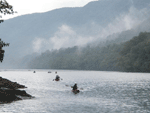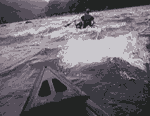
The sound of conversation begins to fade. The canoeists first hear the approaching rapids like the sound of a buzzing bee. That buzzing is soon transformed into the roar of a lion. First, on the surface of the water, small ripples appear to announce the coming of white water. Several boatmen take a second to bow their heads and make a sign of the cross.
The rapids hit and the canoe, prey to every whim of the river, is thrown this way and that. Torrents of water half-fill the boat as waves, caused by uneven contours in the river bed, erupt more than ten-feet above the surface and crash over the bow. The half-filled vessel then becomes nearly unnavigable, but the rough water continues to churn and froth for another quarter mile.
Exhausted, but exhilarated, those who survived the rapids without turning over, paddle to the shore to empty the water from their canoes and reenter the water, ready for more white-water thrills.

This may seem like an inaccessible extreme sport, fun to think about, but impossible to experience. However this and much more is easily accessible to anyone with a canoe and an intrepid spirit.
This is West Virginia’s New River, an exciting waterway that begins in the Blue Ridge Mountains of North Carolina, crosses Virginia and enters West Virginia’s wild and spectacular backwoods.
Roughly forty miles north of the Virginia border, a public launch is available in Sandstone, where an action-packed two-day trip can begin. From Sandstone to Prince, the river winds fifteen miles through some of the most breathtaking views in America. Impressive, but manageable rapids, ranging from Class 1-3 (white water rapids are commonly classified on a scale from 1-6), breakup long runs of flat water and allow canoeists to enjoy both the excitement of white-water canoeing and the beautiful scenery.
Camping facilities (without facilities) are provided free of cost in Prince. Campers should get a good night’s sleep to prepare for the big rapids of day two.
The next fifteen mile stretch from Prince to Thayer makes up the second day of the trip. Although the rapids are fewer and the stretches between them are longer, they are much more difficult. When the water level is over three and a half feet on the Hinton gage, (river level can be checked online at http://waterdata.usgs.gov/wv/nwis/uv?03184500) waves of over five feet should be expected as common, with occasional waves exceeding ten feet.

Due to the inherent danger of such a trip, inexperienced canoeists are not encouraged to attempt the trip when water levels exceed three feet. However when safety precautions are observed and life vests used, the New River’s lack of obstructions require little maneuvering, and make it a relatively safe way to experience big water.
Therefore, the TFP recommends the two-day canoe trip from Sandstone to Thayer. Such an immersion into the marvelous scenery surrounding the New River is a soul-expanding experience which naturally leads to lofty considerations about God and His creation. Moreover, the raging white-water fosters a spirit of adventure which broadens horizons, leaving one unsatisfied with living only in a “comfortable shell.” This spirit gives man the desire to do what others think impossible, give what others think inconceivable and conquer what others think unconquerable.
This spirit is of paramount importance in today’s world.

